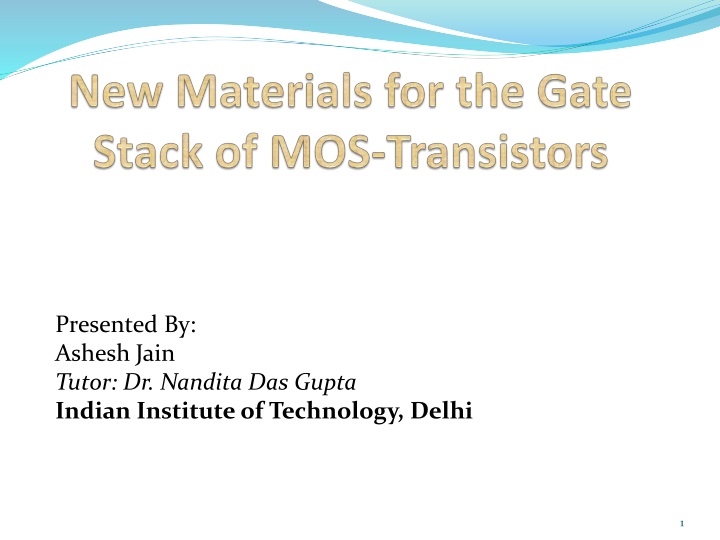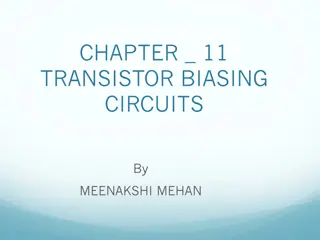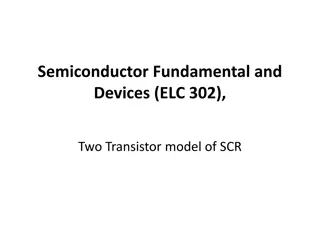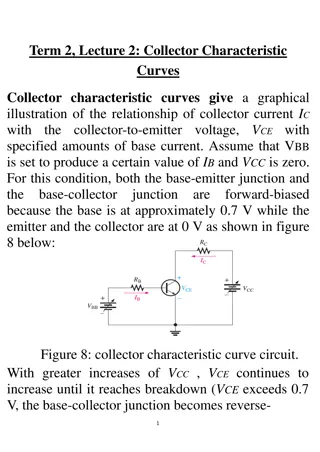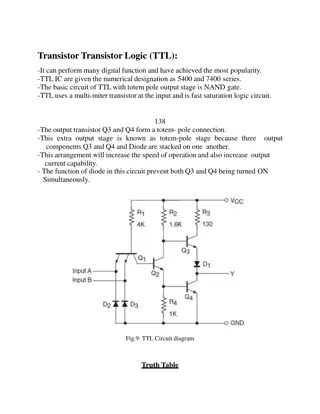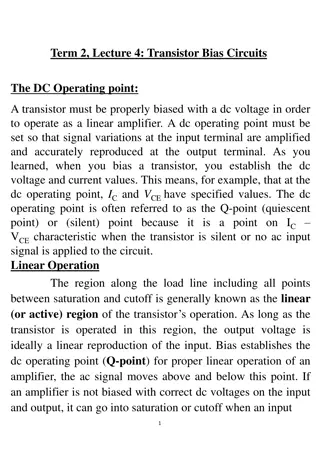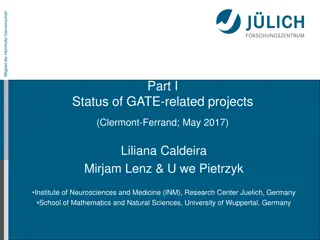Emerging Materials for MOS-Transistor Gate Stacks in Semiconductor Technology
Advancements in semiconductor technology necessitate the adoption of new materials for gate stacks in MOS-transistors, addressing issues like gate leakage current and gate oxide problems. With the continual scaling down of MOSFETs, the use of high-K materials offers solutions to enhance performance and compatibility. The exploration of SiO and Poly-Si advantages, challenges associated with thin gate oxide, and the impact of Moore's Law on transistor density highlight the evolving landscape of semiconductor design.
Download Presentation

Please find below an Image/Link to download the presentation.
The content on the website is provided AS IS for your information and personal use only. It may not be sold, licensed, or shared on other websites without obtaining consent from the author.If you encounter any issues during the download, it is possible that the publisher has removed the file from their server.
You are allowed to download the files provided on this website for personal or commercial use, subject to the condition that they are used lawfully. All files are the property of their respective owners.
The content on the website is provided AS IS for your information and personal use only. It may not be sold, licensed, or shared on other websites without obtaining consent from the author.
E N D
Presentation Transcript
Presented By: Ashesh Jain Tutor: Dr. Nandita Das Gupta Indian Institute of Technology, Delhi 1
Contents Overview of MOSFETs 2. Moore s Law 3. Problems with thin gate oxide: Gate leakage current, Polysilicon gate depletion, Boron penetration 4. High-K oxide solution 5. Choice of high-K materials 6. Permittivity and barrier height 7. Thermodynamic stability on Si 8. Interface quality 9. Film morphology 10. Process compatibility 11. Fermi level pinning and mobility degradation 12. Conclusions 1. 2 New Materials for the Gate Stack of MOS-Transistors
Overview of MOSFETs MOSFET has been continually scaled down in size Reasons: Increase in drive current Higher switching speed More number of transistors on same real estate Scaling leads to short channel effects Gate start losing control over channel charge SiO has to be proportionally scaled to increase gate coupling with channel New Materials for the Gate Stack of MOS-Transistors 3
Advantages of using SiO and Poly-Si Advantages of SiO 1. Thermodynamically stable on Si 2. High quality SiO -Si interface 3. Interface state density, 4. Excellent insulator 10 2 10 / states cm Advantages of poly-Si 1. Easy to fabricate 2. High quality poly-Si/ SiO interface 3. Adjustable Fermi level by controlling dopant concentration 4. Compatible with both PMOS and NMOS New Materials for the Gate Stack of MOS-Transistors 4
Moores Law Coined by Gordon E Moore in Cramming more components onto Integrated circuits published in 1965 Transistor density on the chip doubles every year SiO thickness has to be scaled @ ~0.7x every year New Materials for the Gate Stack of MOS-Transistors 5
Problems associated with thin SiO Thickness of SiO layer required in 45nm technology is about 1.2nm (4 atomic layers deep!!) Gate oxide is running out of atoms Quantum nature of channel electron dominates. Results in: 1. Leaky gate oxide 2. Poly-Si gate depletion 3. Boron penetration New Materials for the Gate Stack of MOS-Transistors 6
Gate Leakage Current Gate oxide 5 atomic layer thick Quantum Mechanical phenomenon of electron tunneling Results in: Leakage current Power consumption Ref [9] New Materials for the Gate Stack of MOS-Transistors 7
Quantum mechanical tunneling Transition of carriers through classically forbidden energy states Electrons tunnel through the dielectric, even if energy barrier is higher than electron energy Two types of tunneling 1. Direct Tunneling (DT) 2. Fowler-Nordheim Tunneling: Ref [6] New Materials for the Gate Stack of MOS-Transistors 8
Direct Tunneling Significant in thin dielectric Tunnels through entire SiO * V 2 A m q = ox exp 2 J t DT ox B 2 2 2 t h ox Tunneling current increases exponentially with decrease in oxide thickness Fowler-Nordheim Tunneling is another tunneling mechanism Take place for thick dielectric at sufficiently high electric field Ref [10] New Materials for the Gate Stack of MOS-Transistors 9
Gate leakage for 0.8nm thick gate oxide Inversion gate leakage measurements of SiO gate oxide for NMOS and PMOS, Ref [2] New Materials for the Gate Stack of MOS-Transistors 10
Consider this.. Presently a processor chip contains about 100million transistors If each transistor leaked a current so high Heating problems will be ensured To reduce leakage, a thicker oxide layer is required. But this means less control over channel charge Moreover: Gate leakage has direct consequences in PD-SOI MOSFETs Modifies the body voltage and related floating body effects Give rise to Gate induced floating body effects (GIFBE) Responsible for kink in characteristics d V I d New Materials for the Gate Stack of MOS-Transistors 11
Gate Depletion In case of thin oxide implant dose of low energy is used for polysilicon gate Polysilicon near the gate oxide is lightly doped Assumption of uniform doping no longer holds Thus a considerable polysilicon gate depletion effect Depletion region thickness becomes very much comparable to oxide thickness Doping concentration in polysilicon gate Vs distance. An annealing of 850 C for 10min was performed after the implant, Ref [1] New Materials for the Gate Stack of MOS-Transistors 12
Contd Results in: 1. Increase in threshold voltage 2. Decrease in drain current 3. A part of the applied gate voltage falls across depletion region Sub threshold drain current Vs gate voltage for different implant conditions, Ref[1] New Materials for the Gate Stack of MOS-Transistors 13
Depletion Layer formation New Materials for the Gate Stack of MOS-Transistors 14
Boron Penetration Boron penetrates from a P+ poly gate electrode through the thin gate oxide into the silicon substrate Threshold voltage decreases Becomes normally on Sub-threshold slope (s-factor) increases Nitridation of gate oxide prevents boron penetration BF I V characteristics of boron penetrated and non boron penetrated PMOS, Ref [4] d g New Materials for the Gate Stack of MOS-Transistors 15
Key points Nitridation: Performed by RTN Nitrogen concentration should be uniform and small at interface Effective in screening boron penetration down to 2nm Boron Penetration: Depends significantly on boron dose Extent of boron penetration is judged by s-factor Fluorine enhances boron penetration New Materials for the Gate Stack of MOS-Transistors 16
Boron concentration with depth BF Dose Boron profile with different boron dose for pure gate oxide(PO). Annealed at 850 C, Ref [4] Boron profile. Nitride oxide(NO) sample in comparison with pure oxide(PO). BF dose 1e15/cm2, Ref [4] New Materials for the Gate Stack of MOS-Transistors 17
S-factor for PO and NO Dependence of subthreshold slope on boron dose Pure oxide(PO): S-factor varies with boron dose Nitride oxide(NO): S-factor is constant with boron dose Boron Dose Sub threshold slope (s factor) dependence on BF dose for low temp. annealing case. = 6.5nm, Ref [4] T ox New Materials for the Gate Stack of MOS-Transistors 18
The High-K oxide solution To continue the scaling trend Increase gate-channel capacitance Scaling SiO further not possible = ox C g t ox t Increase both and K C = ox ox K 0 SiO t = 0 D t 2 g SiO D 2 need to change gate oxide New Materials for the Gate Stack of MOS-Transistors 19
Choice of High-K oxide High-K oxide should satisfy the following properties: 1. High Dielectric constant and Barrier Height 2. Thermodynamic stability 3. Interface Quality 4. Gate compatibility 5. Process Compatibility 6. Fixed oxide charge New Materials for the Gate Stack of MOS-Transistors 20
Potential High-K materials Ref [5] Which one of them is appropriate?? Dielectric constant and band gap of a given material generally exhibit an inverse relationship?? (some materials have significant departure from this trend) New Materials for the Gate Stack of MOS-Transistors 21
Permittivity and Barrier Height = [ ( )] E q Barrier Height: Tunneling current is negligible Leakage current increases exponentially with decreasing barrier height C B M e E C exp( ) J n KT Ta O and TiO have small value of and hence large leakage current HfO and ZrO offer higher value of K and E E g C E g Band Diagram Ref [5] New Materials for the Gate Stack of MOS-Transistors 22
Band offset for high-k gate dielectric material Barrier Height Band offset calculations for a number of potential High-K dielectric materials, Ref [5] New Materials for the Gate Stack of MOS-Transistors 23
Thermodynamic Stability on Si Observations: Most of the High-K metal oxides are unstable on Si Reacts with Si to form an undesirable interfacial layer Interfacial layer may alter the barrier height ( ) Require an interfacial reaction barrier Need to modify both gate and channel interface E C Reaction at Ta O /Si interface resulting in formation of a thin SiO layer, Ref [5] New Materials for the Gate Stack of MOS-Transistors 24
Schematic of two interface Two interface: 1. Upper Interface: Between Gate Electrode and Gate Dielectric 2. Lower Interface: Between Gate Dielectric and Channel Layer (Poly-Si) (High-K oxide) Schematic of important regions of a field effect transistor gate stack, Ref [5] New Materials for the Gate Stack of MOS-Transistors 25
Interface Engineering Developing reaction barriers between high-k/Si interface Depositing an interfacial layer of SiO or low permittivity material Reduce the extent of reaction between high-K and Si High quality SiO -Si interface helps maintain high carrier mobility Limits the highest possible gate stack capacitance 1 1 1 C C C + = / ( 2 = + 1 2 ) EOT t t SiO ox high K high K Increased process complexity New Materials for the Gate Stack of MOS-Transistors 26
Improved Results Comparison of drive current and saturation current for long channel PMOS transistors incorporating SiO /Ta O /SiO dielectric stack, Ref [5] New Materials for the Gate Stack of MOS-Transistors 27
Issues with Interface Engineering For 45nm and below technology EOT~ 1nm is desired Interface layer of SiO ~ 5 thick Problems with thin interfacial layer: 1. Extremely difficult to obtain with high quality 2. Will not prevent reaction between High-K and Si 3. Thin interfacial layer will allow a large amount of direct electron tunneling into the high-k dielectric 4. High electric field in the thin oxide can lead to charge trapping Comparison of stacked and single layer gate dielectrics in a hypothetical transistor gate stack. Either structure results in the same overall gate stack capacitance or EOT= 10 , Ref [5] New Materials for the Gate Stack of MOS-Transistors 28
Thermodynamic stability of metal oxides on Si Al O very stable and robust Stable on Si against SiO formation Drawback : 1. K~ 8 10, hence a short term solution 2. Fixed oxide charge at poly Si/High-K interface 3. Significant mobility degradation 4. Boron diffuses through ALCVD Al O during dopant activation anneals New Materials for the Gate Stack of MOS-Transistors 29
Contd Ta O and TiO unstable to SiO formation Tend to pahse separate into SiO and metal oxide and possibly silicide phases ZrO , HfO stable in direct contact with Si up to high temperature ZrO , HfO can be potential replacement of SiO Pseudobinary alloys and are stable on Si up to high temperatures ( ) ( ) ( ) ( ) HfO xSiO ZrO xSiO 2 2 2 2 1 1 x x New Materials for the Gate Stack of MOS-Transistors 30
Interface Quality Midgap interface state density for SiO , Most of high-K materials reported, Over- or underconstrained interface leads to high interface defect density Y O & La O forms underconstrained interface Ta O & TiO forms overconstrained interface Any M-Si bonding near channel interface lead to poor leakage current and electron channel mobility 10 2 ~ 2 10 / Dit 11 states cm 12 2 ~ 10 10 / Dit states cm New Materials for the Gate Stack of MOS-Transistors 31
Contd. ZrO , HfO have high oxygen diffusivities Any annealing step with excess oxygen will lead to diffusion of oxygen and result in formation of SiO at high-K/Si interface Severely compromise the capacitance gain New Materials for the Gate Stack of MOS-Transistors 32
Film Morphology Polycrystalline films: Amorphous films: Grain boundaries serve as high-leakage paths, and this may lead to the need for an amorphous interfacial layer to reduce leakage current Grain size and orientation changes throughout the film causing variations in K Hence are problematic Exhibit isotropic electrical properties Don t suffer from grain boundaries Can easily be deposited An amorphous film structure is the ideal one New Materials for the Gate Stack of MOS-Transistors 33
Gate compatibility and Metal Gates Most potential High-K dielectric require metal gates Same instability with Si exist at both channel and poly-Si gate interface Metal gates are very desirable for eliminating gate depletion effects Two types of metal electrodes are studied: 1. A single Midgap metal 2. Two separate metals Energy band diagrams of threshold voltages for nMOS and pMOS devices using (a) Midgap metal gates and (b) dual metal gates, Ref [5] New Materials for the Gate Stack of MOS-Transistors 34
Single Midgap metal approach Advantages: 1. Symmetrical for both pmos and nmos 2. Simpler CMOS processing steps, only one mask and one metal would be required for gate electrode Drawbacks: 1. High threshold voltage~0.5V 2. compensation implants will degrade channel carrier mobility 3. Not provide performance improvement worthy of the added process complexity t V t V New Materials for the Gate Stack of MOS-Transistors 35
Dual band metal Separate metal for nmos and pmos Can choose the workfunction of the metal accordingly Can achieve much lower threshold voltage Feasible electrode metal for nmos: Al, Ta, TaN and conducting metal oxide IrO Feasible electrode metal for pmos: Pt and conducting metal oxide RuO Current roadmap predicts that poly-Si gate technology likely be phased out beyond the 70 nm node, after which a metal gate substitute appears to be required New Materials for the Gate Stack of MOS-Transistors 36
Process Compatibility PVD: Sputter PVD results in surface damage thus creating interfacial states Line of sight deposition results in poor step coverage CVD: Provided uniform coverage over complicated device topologies Reaction kinetics require careful attention in order to control interfacial layer formation ALCVD : Gave good results in deposition of HfO and ZrO New Materials for the Gate Stack of MOS-Transistors 37
Replacing poly-Si/SiO by poly-Si/High-K Transistors built using Poly-Si gate and High-K gate oxide suffers from: 1. High threshold voltage because of Fermi level pinning at poly- Si/High-K interface 2. Degraded channel carrier mobility New Materials for the Gate Stack of MOS-Transistors 38
Interface states Observed at metal semiconductor interface Donor states: Donate electrons and become positively charged Above - positive Acceptor states: Accept electrons and become negatively charged Below - negative f E E C Acceptor States 0 E Donor States f E V Semiconductor New Materials for the Gate Stack of MOS-Transistors 39
Fermi Level Pinning Caused by interface states Workfunction of metal differs from its value in vacuum Negatively charged dipole created on dielectric side Dipole drives to ( d CNL eff m S , , + = E E , CNL d , f m ) Negative charge , , m vac CNL d S Slope factor, accounts for dielectric screening Metal Dielectric Interface Higher degree of pinning to E Larger dielectric screening Smaller S d , CNL 40
Fermi Level Pinning at poly- Si/High-K interface Caused by interface defect Hf-Si and Si-O-Al bonds for HfO and Al O respectively Results in: 1. High threshold voltage 2. Low drive current Hence the need to replace poly-Si gate by a suitable metal Defect formation at the polySi and high-K interface is most likely the cause of the Fermi level pinning which causes high threshold voltages in MOSFET (M=Zr or Hf), Ref [6] New Materials for the Gate Stack of MOS-Transistors 41
Mobility Degradation Reason for mobility degradation: Surface phonon scattering in high- dielectrics Mechanism: 1. High-K dielectric has polarizable metal oxygen bonds 2. Oscillating dipoles interacts with channel carriers when gate plasma oscillations and phonons in high-K are in resonance 3. This resonance condition leads to significant degradation of channel carrier mobility Resonance occurs when gate carrier density is To Avoid: Use metal whose free carrier density exceeds Resonance condition is not satisfied Weakens the interaction 19/ 3 1 10 cm 20/ 3 1 10 cm New Materials for the Gate Stack of MOS-Transistors 42
Surface Phonon Limited Mobility Ref [7] Ref [8] New Materials for the Gate Stack of MOS-Transistors 43
Mobility Improvement by using TiN Effective electron mobility as a function of effective vertical electric field, Ref [6] New Materials for the Gate Stack of MOS-Transistors 44
The Metal Gate Solution Metal gates instead of Poly-Si could solve the following problems: Less amount of defects at the surface solving the fermilevel pinning to a certain extent Screening of surface phonon based vibrations because the high concentration of electrons Effectively no depletion layer formation Less resistance compared to poly-Si New Materials for the Gate Stack of MOS-Transistors 45
Metal Gate/High-K Transistor New Materials for the Gate Stack of MOS-Transistors 46
Intel 45nm Transistor performance Performance improvements compared to 65nm transistors: ~2x improvement in transistor density ~30% reduction in switching power ~20% improvement in switching speed >10x reduction in gate oxide leakage power New Materials for the Gate Stack of MOS-Transistors 47
Summary Problems associated with thin SiO SiO need to be replaced by High-K oxide for 45nm and below technology HfO and ZrO show promising results Problems associated with poly-Si/High-K interface Use of metal gate instead of poly-Si give better results 1. 2. 3. 4. 5. New Materials for the Gate Stack of MOS-Transistors 48
References [1] R. Shireen, et al.,"Influence of polysilicon-gate depletion on the subthreshold behaviour of submicron MOSFETs",December 2010 [online] [2] R. Chau, S. Datta, M. Doczy, J. Kavalieros, and M. Metz, Gate dielectric scaling for high performance CMOS: from SiO2 to high- ,Extended Abstract of International Workshop on GateInsulator, Tokyo, Japan, pp. 124 126, 2003 [3] K. Mistry, et al., A 45nm Logic Technology with High-k+Metal Gate Transistors, Strained Silicon, 9 Cu Interconnect Layers, 193nm Dry Patterning, and 100% Pb-free Packaging in Electron Devices Meeting, 2007. IEDM 2007. IEEE International, January 2008, pp. 247-250 [4] T. Morimoto, et al.,"Effects of boron penetration and resultant limitations in ultra thin pure-oxide and nitrided-oxide gate-films" in Electron Devices Meeting, 1990. IEDM '90. Technical Digest., International, pp. 429-432 [5] G. Wilk, et al., "High-k gate dielectrics: Current status and materials properties considerations", Applied Physics Journal, January 2001 New Materials for the Gate Stack of MOS-Transistors 49
References [6] R. Chau et al., Advanced metal gate/high-_ dielectric stacks for high performance CMOS transistors , in AVS 5th Int. Microelectronics InterfacesConf., Santa Clara, CA, 2004, pp. 3 5. [7] R. Chau, et al., Application of high- gate dielectrics and metal gate electrodes to enable silicon and non-silicon logic nanotechnology, Microelectron. Eng., vol. 80, pp. 1 6, Jun. 2005 [8] M. T. Bohr, R. Chau, T. Ghani and K. Mistry, The high-k solution ,IEEE Spectrum-the high-k solution, October 2007 [9]http://www.xtremesystems.org/forums/showthread.php?t=253738&page=4[ Accessed: 3rd December.2010] [10] Chenming Hu, Gate Oxide Scaling Limits and Projection , in Electron Devices Meeting, 1996. IEDM 1996 , pp. 319-322 [11] http://www.iue.tuwien.ac.at/phd/entner/node23.html [Accessed: 6th December, 2010] New Materials for the Gate Stack of MOS-Transistors 50
